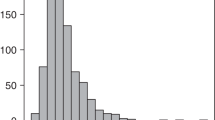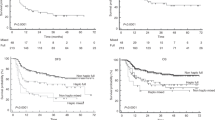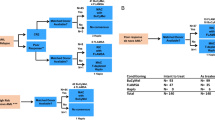Abstract
Data from 170 consecutive patients aged 19–66 years (median age 46 years) who underwent unmanipulated autologous blood stem cell transplant (ASCT) were analyzed to determine if total CD34+ cells/kg infused, CD34+ subsets (CD34+41+, CD34+90+, CD34+33−, CD34+38−, CD34+38−DR−), peripheral blood CD34+ cell (PBCD34+) count on first apheresis day, or various clinical factors were associated with low blood counts 6 months post ASCT. Thirty-four patients were excluded from analysis either because of death (n = 17) or re-induction chemotherapy prior to 6 months post ASCT (n = 13), or because of lack of follow-up data (n = 4). Of the remaining 136 patients, 46% had low WBC (<4 × 109/l), 41% low platelets (<150 × 109/l), and 34% low hemoglobin (<120 g/l) at a median of 6 months following ASCT. By Spearman's rank correlation, both the total CD34+ cell dose/kg and the PBCD34+ count correlated with 6 month blood counts better than any subset of CD34+ cells or any clinical factor. The PBCD34+ count was overall a stronger predictor of 6 month blood counts than was the total CD34+ cells/kg infused. Both factors retained their significance in multivariate analysis, controlling for clinical factors. In conclusion, subsets of CD34+ cells and clinical factors are inferior to the total CD34+ cell dose/kg and PBCD34+ count in predicting 6 month blood counts following ASCT. Bone Marrow Transplantation (2000) 26, 1299–1304.
This is a preview of subscription content, access via your institution
Access options
Subscribe to this journal
Receive 12 print issues and online access
$259.00 per year
only $21.58 per issue
Buy this article
- Purchase on Springer Link
- Instant access to full article PDF
Prices may be subject to local taxes which are calculated during checkout

Similar content being viewed by others
References
Stewart DA, Guo D, Luider J et al. Factors predicting engraftment of autologous blood stem cells: CD34+ subsets inferior to the total CD34+ cell dose Bone Marrow Transplant 1999 23: 1237–1243
Meldgaard Knudsen L, Jensen L, Jarlbaek L et al. Subsets of CD34+ hematopoietic progenitors and platelet recovery after high dose chemotherapy and peripheral blood stem cell transplantation Haematologica 1999 84: 517–524
Weaver CH, Hazelton B, Birch R et al. An analysis of engraftment kinetics as a function of the CD34 content of peripheral blood progenitor cell collections in 692 patients after the administration of myeloablative chemotherapy Blood 1995 86: 3961–3969
Pecora AL, Preti RA, Gleim GW et al. CD34+CD33− cells influence days to engraftment and transfusion requirements in autologous blood stem-cell recipients J Clin Oncol 1998 16: 2093–2104
Olivieri A, Offidani M, Montanari M et al. Factors affecting hemopoietic recovery after high-dose therapy and autologous peripheral blood progenitor cell transplantation: a single center experience Haematologica 1998 83: 329–337
Ketterer N, Salles G, Raba M et al. High CD34(+) cell counts decrease hematologic toxicity of autologous peripheral blood progenitor cell transplantation Blood 1998 91: 3148–3155
Krause DS, Fackler MJ, Civin CI et al. CD34: structure, biology, and clinical utility Blood 1996 87: 1–13
Buhring HJ, Asenbauer B, Katrilaka K et al. Sequential expression of CD34 and CD33 antigens on myeloid colony-forming cells Eur J Haematol 1989 42: 143–149
Loken MR, Shah VO, Dattilio KL et al. Flow cytometric analysis of human bone marrow: I. Normal erythroid development Blood 1987 69: 255–263
Debili N, Issaad C, Masse JM et al. Expression of CD34 and platelet glycoproteins during human megakaryocytic differentiation Blood 1992 80: 3022–3035
Henon P, Sovalat H, Becker M et al. Primordial role of CD34+ 38− cells in early and late trilineage haemopoietic engraftment after autologous blood cell transplantation Br J Haematol 1998 103: 568–581
Amigo ML, del Canizo MC, Caballero MD et al. Factors that influence long-term hematopoietic function following autologous stem cell transplantation Bone Marrow Transplant 1999 24: 289–293
Perez-Simon JA, Martin A, Caballero D et al. Clinical significance of CD34+ cell dose in long-term engraftment following autologous peripheral blood stem cell transplantation Bone Marrow Transplant 1999 24: 1279–1283
Haas R, Witt B, Mohle R et al. Sustained long-term hematopoiesis after myeloablative therapy with peripheral blood progenitor cell support Blood 1995 85: 3754–3761
Kiss JE, Rybka WB, Winkelstein A et al. Relationship of CD34+ cell dose to early and late hematopoiesis following autologous peripheral blood stem cell transplantation Bone Marrow Transplant 1997 19: 303–310
Stewart DA, Guo D, Morris D et al. Superior autologous blood stem cell mobilization from dose-intensive cyclophosphamide, etoposide, cisplatin plus G-CSF than from less intensive chemotherapy regimens Bone Marrow Transplant 1999 23: 111–117
Terstappen LW, Huang S, Safford M et al. Sequential generations of hematopoietic colonies derived from single nonlineage-committed CD34+CD38− progenitor cells Blood 1991 77: 1218–1227
Bernstein ID, Leary AG, Andrews RG et al. Blast colony-forming cells and precursors of colony-forming cells detectable in long-term marrow culture express the same phenotype (CD33- CD34+) Exp Hematol 1991 19: 680–682
Brandt J, Baird N, Lu L et al. Characterization of a human hematopoietic progenitor cell capable of forming blast cell containing colonies in vitro J Clin Invest 1988 82: 1017–1027
Schots R, Van Riet I, Damiaens S et al. The absolute number of circulating CD34+ cells predicts the number of hematopoietic stem cells that can be collected by apheresis Bone Marrow Transplant 1996 17: 509–515
Perez-Simon JA, Caballero MD, Corral M et al. Minimal number of circulating CD34+ cells to ensure successful leukapheresis and engraftment in autologous peripheral blood progenitor cell transplantation Transfusion 1998 38: 385–391
Cleeland CS, Demetri GD, Glaspy J et al. Identifying hemoglobin level for optimal quality of life: results of an incremental analysis J Clin Oncol 1999 18: 2215 (Abstr.)
Glaspy J, Bukowski R, Steinberg D et al. Impact of therapy with epoetin alfa on clinical outcomes in patients with nonmyeloid malignancies during cancer chemotherapy in community oncology practice. Procrit Study Group J Clin Oncol 1997 15: 1218–1234
Lee J, Kook H, Chung I et al. Telomere length changes in patients undergoing hematopoietic stem cell transplantation Bone Marrow Transplant 1999 24: 411–415
Friedberg JW, Neuberg D, Stone RM et al. Outcome in patients with myelodysplastic syndrome after autologous bone marrow transplantation for non-Hodgkin's lymphoma J Clin Oncol 1999 17: 3128–3135
Bernstein ID, Andrews RG, Rowley S . Isolation of human hematopoietic stem cells Blood Cells 1994 20: 15–23
Verfaillie CM . Soluble factor(s) produced by human bone marrow stroma increase cytokine-induced proliferation and maturation of primitive hematopoietic progenitors while preventing their terminal differentiation Blood 1993 82: 2045–2053
Lange C, Kaltz C, Thalmeier K et al. Hematopoietic reconstitution of syngeneic mice with a peripheral blood-derived, monoclonal CD34−, Sca-1+, Thy-1(low), c-kit+ stem cell line J Hematother Stem Cell Res 1999 8: 335–342
Bhatia M, Bonnet D, Murdoch B et al. A newly discovered class of human hematopoietic cells with SCID-repopulating activity Nature Med 1998 4: 1038–1045
Author information
Authors and Affiliations
Rights and permissions
About this article
Cite this article
Duggan, P., Guo, D., Luider, J. et al. Predictive factors for long-term engraftment of autologous blood stem cells. Bone Marrow Transplant 26, 1299–1304 (2000). https://doi.org/10.1038/sj.bmt.1702708
Received:
Accepted:
Published:
Issue Date:
DOI: https://doi.org/10.1038/sj.bmt.1702708
Keywords
This article is cited by
-
Development and validation of a predictive model to guide the use of plerixafor in pediatric population
Bone Marrow Transplantation (2022)
-
Oral calcitriol in hematopoietic recovery and survival after autologous stem cell transplantation: a randomized clinical trial
DARU Journal of Pharmaceutical Sciences (2019)
-
Long-term graft function following autologous hematopoietic cell transplantation and the impact of preemptive plerixafor in predicted poor mobilizers
Blood Cancer Journal (2018)
-
Improving stem cell mobilization strategies: future directions
Bone Marrow Transplantation (2009)
-
Low doses of GM-CSF (molgramostim) and G-CSF (filgrastim) after cyclophosphamide (4 g/m2) enhance the peripheral blood progenitor cell harvest: results of two randomized studies including 120 patients
Bone Marrow Transplantation (2006)



